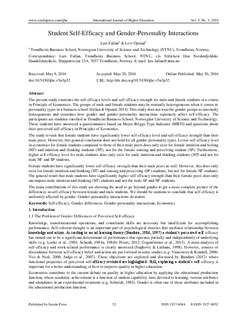| dc.contributor.author | Opstad, Leiv Trygve | |
| dc.contributor.author | Fallan, Lars | |
| dc.date.accessioned | 2016-11-21T13:45:58Z | |
| dc.date.accessioned | 2017-02-01T08:13:13Z | |
| dc.date.available | 2016-11-21T13:45:58Z | |
| dc.date.available | 2017-02-01T08:13:13Z | |
| dc.date.issued | 2016 | |
| dc.identifier.citation | International Journal of Higher Education 2016, 5(3):32-45 | nb_NO |
| dc.identifier.issn | 1927-6052 | |
| dc.identifier.uri | http://hdl.handle.net/11250/2429095 | |
| dc.description.abstract | The present study examines the self-efficacy levels and self-efficacy strength for male and female students in a course in Principle of Economics. The groups of male and female students may be mutually heterogeneous when it comes to personality types in a business school (Fallan & Opstad, 2014). This study does not treat the gender groups as internally homogeneous and examines how gender and gender-personality interactions separately affect self-efficacy. The participants are students enrolled at Trondheim Business School, Norwegian University of Science and Technology. These students have answered a questionnaires based on Meyer-Briggs Type Indicator (MBTI) and questions about their perceived self-efficacy in Principles of Economics.
The study reveals that female students have significantly lower self-efficacy level and self-efficacy strength than their male peers. However, this general conclusion does not hold for all gender-personality types. Lower self-efficacy level in economics for female students compared to those of their male peers does only exist for female intuition and feeling (NF) and intuition and thinking students (NT), not for the female sensing and perceiving student (SP). Furthermore, higher self-efficacy level for male students does only exist for male intuition and thinking students (NT) and not for male NF and SP students.
Female students have significantly lower self-efficacy strength than their male peers as well. However, this does only exist for female intuition and thinking (NT) and sensing and perceiving (SP) students, but not for female NF students. The general result that male students have significantly higher self-efficacy strength than their female peers does only encompass male intuition and thinking (NT) students and not the male SP and NF students.
The main contributions of this study are showing the need to go beyond gender to get a more complete picture of the differences in self-efficacy between female and male students. We should be cautions to conclude that self-efficacy is uniformly affected by gender. Gender-personality interactions do matter. | nb_NO |
| dc.language.iso | eng | nb_NO |
| dc.publisher | Sciedu Press | nb_NO |
| dc.subject | Self-efficacy, Gender differences, Gender-personality interactions, Economics | nb_NO |
| dc.title | Student Self-Efficacy and Gender-Personality Interactions | nb_NO |
| dc.type | Journal article | nb_NO |
| dc.type | Peer reviewed | nb_NO |
| dc.date.updated | 2016-11-21T13:45:58Z | |
| dc.source.pagenumber | 32-45 | nb_NO |
| dc.source.volume | 5 | nb_NO |
| dc.source.journal | International Journal of Higher Education | nb_NO |
| dc.source.issue | 3 | nb_NO |
| dc.identifier.doi | 10.5430/ijhe.v5n3p32 | |
| dc.identifier.cristin | 1402462 | |
| dc.description.localcode | This journal provides immediate open access to its content on the principle that making research freely available to the public supports a greater global exchange of knowledge. | nb_NO |
